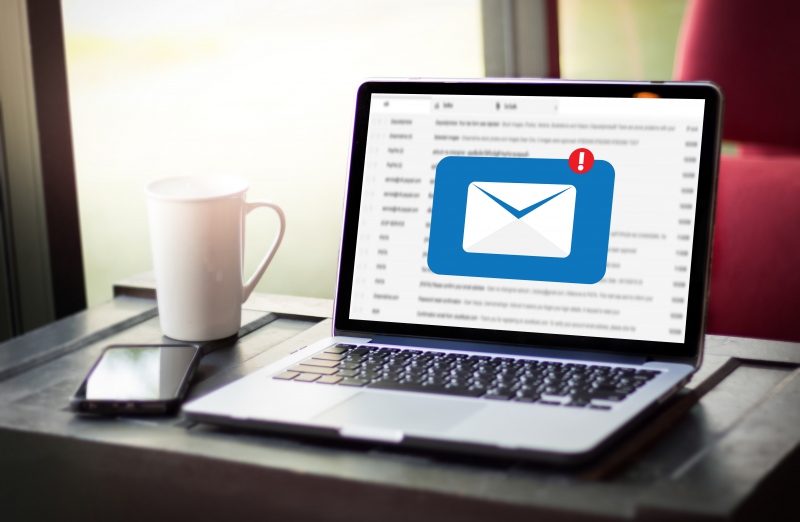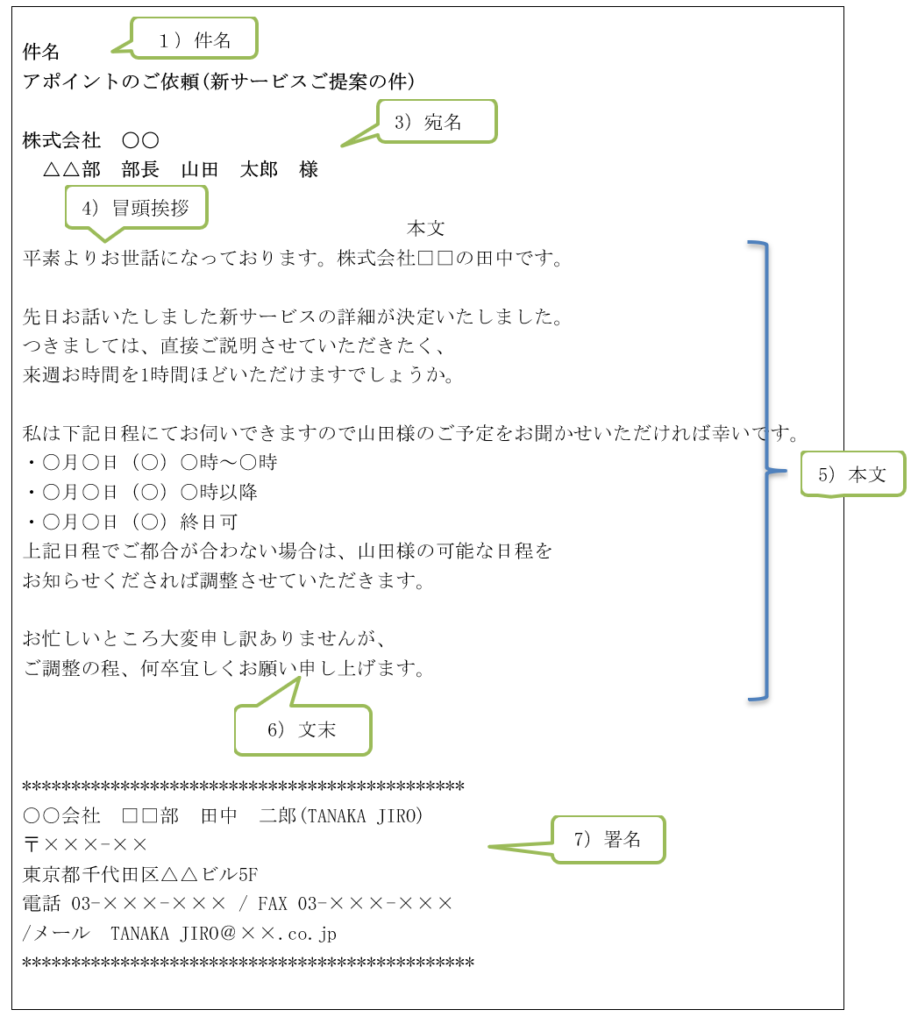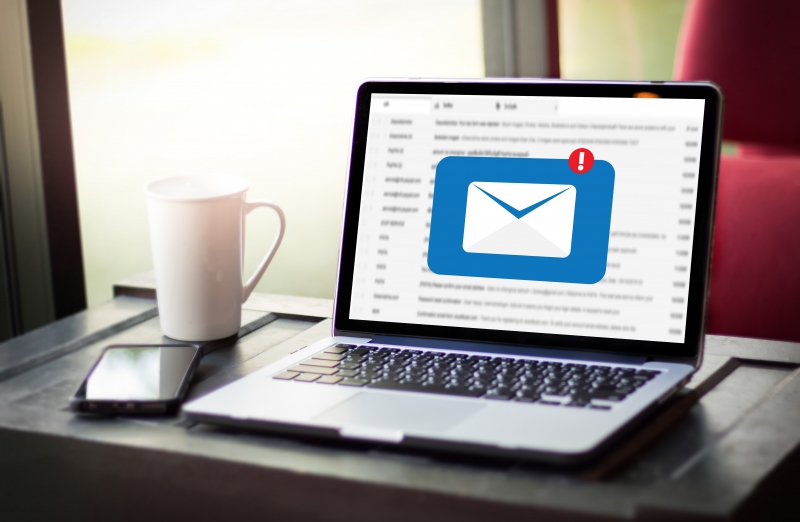Whether you’re already working in Japan or about to enter the Japanese corporate world, you should definitely read this article if you want to learn the secrets of Japanese business emails. From ready-to-use sample sentences to things to watch out for and avoid, this guide has everything you will need.

Seven Basic Rules You Must Know!
Japan has its own unique rules when it comes to writing business emails. If you don’t follow them, you risk making a bad impression on the recipient from the first sentence, which might negatively affect your job prospects. To avoid that, here’s what you should be mindful of.

1) Subject: Summarize the contents of the email in a concise, easy-to-understand manner
Try to keep your Subject within 20 Japanese characters, and make it so that the recipient can understand what you want to know or say with just a quick glance at it. If you make it too long, the Subject might be cut off, so please be careful.
A Japanese businessman receives dozens to hundreds of emails every day. That’s why the Subject has to let them know what the email is about even without opening it. If you do that, then they will treat your message as a priority and respond to it first since they’ll already know what to expect. For this reason, subjects such as “○○社の件” (About the Company) or “研修の件について” (About Training) where you can’t really tell what the purpose of the email is should be avoided.
It is better to use subjects that let the recipient know instantly what the email is about, such as “〇〇社 見積もり確認依頼” (Estimate Confirmation Request for OO Company) or “ビジネスメール研修(10/15)実施のお知らせ” (Notification Concerning the 10/15 Business Email Training). If the email is urgent, you can start your Subject with “重要” (Important) or ”要返信” (Reply Required), as long as you’re careful not to overuse these.
2) Address: Know the Difference Between TO, CC, and BCC
Before you send the same email to multiple recipients, please make sure that you understand what the following terms mean:
TO: The person in charge and the primary recipient of the email.
CC and BCC are used to simultaneously send the email to secondary recipients but they are not the same.
CC (Carbon Copy): An additional recipient whose email address will be visible to all recipients.
BCC (Blind Carbon Copy): Neither the name nor the address of the recipient will be visible to others.
Even if you’re contacting people you know, they may not all know each other, in which case CC’ing them might give away their private information, so please be careful. For example, accidentally CC’ing all of your clients on a single email is a very common mistake. If you’re unsure whether to use CC or BCC, don’t be afraid to ask for help.
3) Name: What to Write Besides Someone’s Name (When Writing to an Individual)
Make sure to include the name of the recipient’s company and department before writing their name. E.g.:
株式会社○○ (Company Name)
△△部 (Department)
部長 山田 太郎 様 (Department Head Taro Yamada)
If the recipient holds a managerial title, write it before their name. Using their full name would be best but if you don’t know it, just their surname will suffice. Also, don’t forget about the “sama” suffix (様) after their name as it’s a sign of respect. Do not write “sama” after their managerial title.
When addressing multiple people:
○○会社 (Company Name)
△△部各位 (To All ___ Department Members)
There is no reason to write out the names of every recipient. “各位” (To All) will do just fine. It’s already an honorific expression, so there’s no need to add “sama” at the end.
When addressing an organization instead of an individual:
○○会社 (Company Name)
△△部御中 (To the Attention of the ___ Department)
“御中” (oncho) is an honorific term used for groups and organizations. It is never used for individual people.
NOTE: Misspelling or writing the wrong company/recipient name is considered incredibly rude in Japan. Please take the time to make sure you’ve used all the correct characters in your email.
4) Beginning of the Email: Start With a Polite Greeting
There are various greetings you can use, depending on whether you’re contacting someone within the company or outside the company. Just don’t forget to write your name and the name of your company after the initial greeting.
When writing to someone from outside your company:
• いつもお世話になっております。(Thank you for your continued support)
• 日頃よりご愛顧賜りありがとうございます。(Thank you for your patronage)
• (早速の)ご連絡ありがとうございます。 (Thank you for getting in touch (so quickly) [when replying to someone])
• 先日は貴重なお時間をいただき誠にありがとうございました。(Thank you for setting your valuable time aside for us the other day [after being contacted by someone])
• 大変ご無沙汰しております。(We haven’t spoken for a long time)
• ご不在でしたので、メールにてご連絡させていただきます。(I was out so I’m taking the liberty of contacting you by email [when the other party tried reaching you by phone earlier])
• 何度も申し訳ございません。/度々失礼いたします。(Terribly sorry for bothering you so many times [used when contacting someone numerous times in a day])
• お世話になります。/初めてご連絡させていただきます。/突然のご連絡失礼いたします。(Thank you for your support / I’ve taken the liberty of contacting you / So sorry for suddenly contacting you [used when contacting someone for the first time])
• 先日はご迷惑をおかけいたしまして大変申し訳ございませんでした。(My sincere apologies for inconveniencing you the other day [used when apologizing])
When writing someone from within your company:
• お疲れ様です。(Thank you for your hard work.) Used to express gratitude for each other’s hard work. NOTE: This expression can only be used for people within your company. It would be considered rude to use it with someone from outside the company.
• ご苦労様。(Good job.) This is usually used towards subordinates so it’d be best to avoid it altogether.
5) Body of the Email: Don’t Waste Time and Try to Keep Things Clear and Simple
A 2015 survey has found that the number one complaint people have when it comes to business emails are vague sentences. Other major complaints included hard to follow sentences or problems with understanding the contents of the email due to insufficient information. Sentences that came off as rude and typographical errors were in the Top 10 of that list. It bears repeating but the body of the email has to state clearly and simply everything you want to convey. Besides content, you should also make sure that the email looks good. Avoid writing a difficult-to-follow email by following the these rules:
- Each issue should be addressed in a separate email (discussing multiple issues in one email can easily lead to confusion and mistakes.)
- Uses tables and bullet points, and don’t forget to separate your email into paragraphs.
- Cite the recipient’s questions when answering them.
- When talking about a request, be clear about the deadline.
- Clarify who is the person in charge of the issue you’re addressing (who do you want to take care of the matter or who from your company is taking care of it, etc.)
- After you’re done composing the email, make sure that it follows all these rules, that there are no issues with the content, and that it looks good.
6) End of the Email: Leave a Good Impression With the Right Phrase
The most popular phrase to use at the end of an email is “よろしくお願いいたします” (Kind regards.) It’s a good choice but if you keep corresponding with the same person and keep using the same phrase at the end, it can lose its meaning. Here’s how you can mix things up depending on the situation:
General:
• (どうぞ)よろしくお願いいたします。(Warmest/kind regards)
• 引き続きよろしくお願いいたします。(Thank you for your continued support)
• よろしくお願い申し上げます。(Kind regards [most polite])
After part of a deal with a client has been concluded:
• 今後ともご指導のほど、よろしくお願い申し上げます。(Thank you for your continued guidance. Kind regards.)
• 今後とも変わらぬお引き立てのほどお願い申し上げます。(We look forward to your continued patronage)
When asking for a reply:
• ご検討のほどよろしくお願いします。(Thank you for your consideration)
• ご確認のほどよろしくお願いいたします。(Thank you for looking into it)
When expressing thanks:
• 誠にありがとうございました。(My sincerest thanks)
• 心より感謝申し上げます。(Thank you from the bottom of my heart.)
When apologizing:
• 心よりお詫び申し上げます。(I sincerely apologize)
• ご期待に沿えず申し訳ございませんでした。(I apologize for not meeting your expectations)
When declining:
• またの機会がございましたら、どうぞよろしくお願いいたします。(Perhaps another time. Warmest regards.)
• ご期待に沿えず恐縮ですが、今後ともどうぞよろしくお願いいたします。(We apologize for the inconvenience, but we look forward to your continued support.)
7) Signature: Don’t Forget to Include Your Contact Information
Include the following information in your signature:
• Company name, department name
• Name
• Postal code, address
• Telephone/fax number
• Email address, website URL
• Holidays, days off (with certain industries)
Example:
○○会社 (Company Name) □□部 (Department) 田中 二郎 (Name)
〒×××-×× (Postal code)
東京都千代田区△△ビル5F (Address)
電話 03-×××-××× / FAX 03-×××-××× (Telephone/fax number)
メール TANAKA JIRO@××.co.jp (Email Address)
How to Leave a Good Impression and Gain the Recipient’s Trust

1) Use Honorific Language (keigo)
It’s difficult to properly convey emotions in an email so be sure to use polite words and phrases. Avoid colloquialism, don’t be informal, and remember to use keigo (honorific Japanese). However, be careful not to mix up “sonkeigo” with “kenjogo”—the former elevates the recipient while the latter contains humble expressions used when talking about oneself or one’s group. Be very careful to get this right because if you mix them up, you may appear to be talking down to the email’s recipient. We’ll now discuss the most common mistakes that people make.
When talking about your supervisor (Mr. A) to someone from outside the company, use kenjogo.
E.g. “Aが○○と申しております。” (Mr. A said [humble version])
Even though your boss is above you, because you are talking to someone outside your company’s hierarchy, you should not elevate them with phrases like “Aがおっしゃっている” (Mr. A said [honorific version])
However, when sending an internal email and talking about Mr. A, you would use the honorific “Aがおっしゃっている” to express your respect for your supervisor.
2) Seasonal Greetings
Seasonal greetings are expressions containing words/phrases relating to the season or the current month that appear at the beginning of a correspondence. The tradition hails back to formal letters and thank-you-notes but they often appear in emails as well. They are set phrases, so all you have to do is pick a month and copy the correct seasonal greeting into your email. Please note, however, that seasons differ somewhat depending on the region, so none of these phrases are set in stone. If you feel that you want to start an email with “桜のきれいな季節になりました” (The sakura cherry trees are quite lovely now), then you should do it.
References:
Seasonal Greetings Used in Letters
Seasonal Greetings Used in Emails
3) Be Considerate
We’ve already mentioned that when composing a business email, you have to be clear and concise. However, knowing when to also include words of kindness is an important skill that will help you greatly in the Japanese corporate world. When you are considerate towards the recipient, you will be taking a small step towards building an amicable relationship with them.
When asking for something:
• お忙しいところ申し訳ございませんが (My apologies. I know you must be very busy but…)
• ご多忙の中とは存じますが (I know you are very busy but…)
• ご不明点がありましたら、お気軽にご質問下さいませ。(If there’s anything I can clear up for you, please let me know)
When thanking for something:
• 早速お返事をいただき、どうもありがとうございました。(Thank you for your prompt response)
• 行き届いたお心配りに感謝いたします。(Thank you for being so thoughtful)
• お忙しいと思いますが、お体にお気を付け下さい。(You must be very busy but please take care of yourself)
The Big Don’ts! Things to Avoid in Japanese Business Emails
When writing a business email, failing to use honorific language and making typographical errors can easily leave a bad impression on the recipient. In order to avoid this, here are some things to always keep in mind:

Use Appropriate Names
• Your company is “弊社” while someone else’s company is “貴社” or “御社”
• Do not use suffixes like “san” or “sama” when talking about people from your own company, but always use the suffix “sama” when referring to people outside of your company. When sending an internal email, you may use “san.”
Things to Avoid
• Don’t confuse “sonkeigo” and “kenjogo” (it will seem that you’re looking down on the recipient)
• Keep the number of emails low (don’t bother people for a reply)
• Don’t be overly casual as if you were emailing a friend. Needless to say, symbols and emojis such as ♪(^^♪ are off the table
• No matter how many times you write to someone, do not forget the “お世話になっております。/度々すみません●●会社の●●です。” greetings, and always end your email with “よろしくお願い致します”
• Do not send out emails early in the morning or late at night (try to keep your correspondence to within typical working hours, from around 8:30 am to 7:00 pm)
• Don’t make your emails too long or too short
• In order to avoid the email subject being a string of “Re:” be sure to alter it after a prolonged email exchange
• When reprimanding someone, it’s better to call them on the phone (doing it by email will leave a bad impression)
• Don’t overuse or underuse paragraph breaks (make the email easy to read)
• Make sure not to make any typographical or spelling errors (especially when it comes to the company name, personal names, product names, etc.)
• Avoid using too much hiragana as it will make the email difficult to read
Words that should be spelled using hiragana:
• ありがとうございます/こんにちは/こんばんは (Thank you/Hello/Good Morning/Good Evening)
• よろしくお願いします。(Do not spell “yoroshiku” as “宜しく”)
Words that can be spelled with either hiragana or kanji:
• Sama (様 or さま) “様” is usually the safer choice in business emails. “さま” isn’t wrong per se, but it suggests a degree of familiarity
References (Japanese):
https://www.mine-3m.com/mine/news/image?news_id=15852
Ready-to-Use Sample Sentences Perfect for Any Occasion!
Let’s take everything we’ve discussed up until now and try to compose a Japanese business email. These will just be the email bodies, five for different situations, without the subject, recipient’s name, or the signature. Feel free to modify them in order to make them sound more like you.
【営業(商品やサービスに関する提案)】
平素は弊社商品「○○」をご利用いただき誠にありがとうございます。
__月__日より新商品「○○」の発売が開始されます。
なにとぞご検討のほどよろしくお願いいたします。
なお、ご注文は田中までご連絡ください。お見積もりを作成させていただきます。
何かご不明な点がございましたらお気軽にお問合せください。
[Information About a New Product or Service]
Thank you for using “OO”products.
Starting on ___, a new product, “OO”, will become available.
We hope that it will be of interest to you. Thank you for your consideration.
For orders, please contact Tanaka. We’ll be happy to send you an estimate.
If there’s anything I can clear up for you, please let me know.
【見積もり依頼】
先日は新商品のご提案ありがとうございました。
早速ですが田中様よりご提案いただきました新商品「○○」の導入を検討しております。
つきましては以下の内容で見積書作成をお願いいたします。
見積商品
1.新商品「〇〇」×100セット
2.支払方法
3.受け取り場所 弊社○○支店
見積書を参考に弊社にて予算調整等行うため__月__日までにいただけますと大変助かります。勝手を申し上げて恐縮ですが、ご検討よろしくお願いいたします。
[Request for an Estimate]
Thank you letting us know about the new product.
We’ve looked into the proposal regarding the implementation of “OO” sent by Mr. Tanaka. We are therefore asking for an estimate for the following:
Estimate:
- New Product, “OO” x 100 sets
- Methods of Payment
- Place of Delivery, the OO branch.
The estimate will help us adjust our budget, so if you could send us something by the ___, it would be greatly appreciated. Sorry to ask for so much of you, and thank you in advance.
【訪問、リモート打ち合わせのお礼】
お世話になっております。株式会社○○ 田中 次郎です。
本日はお忙しい中、貴重なお時間をいただき誠にありがとうございました。
○○様から頂きましたご要望、ご質問について弊社にて検討の上、
来週 __曜日(__日)までに回答させていただきます。
なお、ご不明な点等ございましたらご連絡ください。
引き続きよろしくお願いいたします。
[Thank You for Contacting Us]
Thank you for your continued support. I’m Tanaka Jiro of OO Company.
I know you must be busy so thank you for setting your valuable time aside for us.
I received the request from Mr. OO and looked into it, and I will be able to offer my response by ___ next week.
If there’s anything else I can clear up for you, please let me know.
Kind regards.
【書類確認のお願い】(社内)
お疲れ様です。○○部 △△です。
新商品○○ 販売戦略企画書が完成いたしましたのでファイルを添付します。
ご確認お願いいたします。
お忙しいところ申し訳ございませんが、
__月__日の会議資料となりますので修正、変更点は
__日午前中までにご返信いただきますようよろしくお願い申し上げます。
[Request for Document Verification (Internal Email)]
Thank you for your hard work. It’s △△ from the OO department.
I have completed the sales strategy proposal for the new product, OO, and have attached it to this email. Could you please look it over?
My apologies. I know you must be very busy but these documents will be needed for the meeting on __, so could you send me any corrections and other changes by ___?
Kind regards.
【打ち合わせのお願い】(社内)
お疲れ様です。○○部田中です。
新商品○○ 販売戦略会議についてご連絡します。
日時 2020年__月__日(__)13:00~15:00
会場 会議室A
資料 添付ファイル
出欠連絡 __月__日(__) 18:00まで(○○部田中に お願いします。)
新商品の営業活動の方針を検討する重要な会議となりますので、各自スケジュール調整を お願いいたします。
[Request For a Meeting (Internal Email)]
Thank you for your hard work. It’s Tanaka from the OO department.
I’m writing you with information about the sales strategy meeting for the new product, OO.
Date: ___, 2020, 1:00 pm – 3:00 pm
Place: Meeting Room A
Documents: attached
Please confirm your attendance by 6:00 pm on ___ (to Tanaka from OO department, please).
The meeting will concern the direction in which we want to take the new product so please adjust your schedule in order to make it.
Conclusion
A Japanese office worker always takes other people’s feelings into consideration in order to create a good working environment. One of the tools that help work to flow more smoothly is the ability to write proper business emails, the rules of which we’ve discussed in this article. However, if you’re still having problems with it or if you’re feeling unsure about using honorific Japanese properly, don’t be afraid to ask a Japanese coworker for help.
If you want to give feedback on any of our articles, you have an idea that you’d really like to see come to life, or you just have a question on Japan, hit us up on our Facebook!
The information in this article is accurate at the time of publication.

